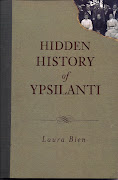
This photo was stored electronically at the Archives on the main computer. When I first clicked on it, not knowing what it was, the image filled the screen and
freaked me right the heck out--stark, candid, strange.
But who was the woman on the left? Could she be found?
The photo file name is loomis,alta_friend.jpg. Was Alta Loomis the name of one of these women? A census search for the years 1880-1920 (I guessed by the clothing that this photo was from the early part of the 20th century)--and found 2 Alta Loomises, one in Muskegon and one in Ionia. Ionia's not that far...was Alta related to Ypsilantians? Otherwise why would the Archives have this photo?
Then I simplified the census search to "Loomis" in Ypsi and found several Loomises. No Alta. I took a look in the 1905 city directory. Wait--there was an Elta Loomis, "teacher." Grade school? High school? Perhaps the Normal School?

And the address, 706 Emmet, at which she was boarding was the same as "Loomis, Miles," a traveling salesman, and his wife Mary. Were Miles and Mary her parents?

I looked in a 1907 yearbook from the Normal School. Loomis...Loomis...aha, there was a L. Loomis next to...drat, a composite photo with many faces. The names weren't keyed to the various portraits. Two of the portraits had been annotated with "Alice Boardman" and "Clyde Foster" in a script I recognized as that of former city archivist Dorothy Disbrow, who retired in 1980.

Then I checked a 1913 yearbook. Aha--L. Elta Loomis, a physical education teacher. But the picture was so tiny (actual size below). I fixed on her eyebrows, the single most distinctive feature in the small picture. Heavy and kind of floating above her nose...

Back to the 1910 census to look for Miles and Mary. There they were in the 1910 census: Miles, Mary, and "Lulu E.," who was listed as a teacher at the Normal.
There you are, Lulu.

Or was she? Which woman in the initial photo was Lulu Elta Loomis? The picture in the 1913 yearbook was only an inch wide. I took off my glasses and studied her features up close...but her picture was too tiny to be able to get a fix on her features. Magnifying glass.

I remembered I had another photo labeled "Loomis Group 2." Perhaps she might be pictured there--assuming that the five women in the photo were all Loomises.

Wait, what about this woman? What a beauty.

Was she the same one as in the 1913 yearbook?


It seemed so! Back to the composite photo.

Hmmm......?



The facial features seem to be the same...plus an indefinable look of mingled melancholy and mirth in her gaze across all of the photos. Is this the woman in the window?




Maybe.
A last bit of sleuthing reveals that Lulu was born in 1883. On September 4, 1913, at age 30, she married physician David Lewis Dunlap in Ypsilanti. By 1930, the couple lived in Wayne County's Highland Park. David was 52 and Lulu was 46. She had 4 children: 15-year-old Ward Comstock, 14-year-old David Bruce, 13-year-old Gregg Loomis, and 6-year-old Jean Dean. Lulu's widowed mother Mary lived with the family.
Lulu would outlive David, surviving until age 89. She died in 1972.
Many years earlier, she had been a beautiful young woman laughing with her friend. She never guessed that her expression of meditative suppressed humor would be, a century later, a thing of mystery and wonder.

 Here are this week's stories for a kind reader's perusal, should you have a spare moment.
Here are this week's stories for a kind reader's perusal, should you have a spare moment.
























































